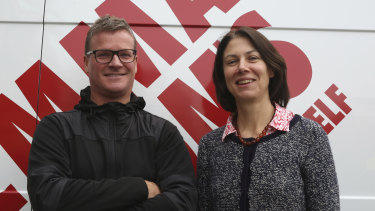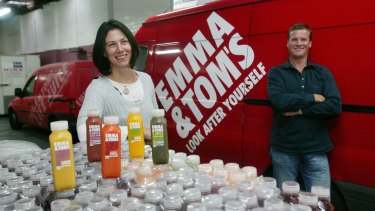Emma Welsh and Tom Griffith were struggling with their drinks business, Emma & Tom’s, but buying a van turned everything around.
“We didn’t have good enough systems back in those days, and it took us a long time to work out we were churning 40 per cent of our customers by using a distributor,” Griffith says on the sidelines of Netsuite’s SuiteConnect conference in Sydney.


Emma Welsh and Tom Griffith founded Emma & Tom’s drinks company.
The childhood friends, who first met during swimming lessons at Harold Holt memorial pool, started Emma & Tom’s in 2004 after spotting a thirst for green juices in Australia.
The business now turns over more than $10 million a year and its range has expanded to 80 products, including juice, kombucha, kefir water and healthy snacks.
Griffith and Welsh trace their success to a decision to take on distribution themselves.
“Emma was sitting at her computer on a wet August afternoon and she said: ‘We can trade our way out of this’. We basically got the van and started selling from it.”
Emma & Tom’s also struggled with cash flow, and 90-day payment times from their distributor.
Welsh says that, when they started losing customers, they knew it wasn’t the product – it had to be the service.
“It meant we changed the business model. We became a brand with its own distribution as opposed to a brand outsourcing its distribution,” she says. “I don’t think we would have survived in business if we hadn’t started doing our own distribution.”
Emma & Tom’s now has a fleet of 40 refrigerated vans that deliver to 8000 outlets nationwide. Griffith and Welsh say having their own distribution network sets them apart from their competitors.
“The vans give us great flexibility. And we also think that the vans, because they are branded of course, if you cost them as the equivalent of, say, a bus shelter (which has two sides as opposed to four in a van), they are worth up to $5 million a year in equivalent ad spend.”


Emma Welsh and Tom Griffith in the early days of Emma & Tom’s. CREDIT: ERIN JONASSON
Emma & Tom’s has been able to capitalize on increases in demand for healthy food and drinks.
Economic analysis published by the CSIRO last year found the rising interest in healthy and sustainable lifestyles could be worth $25 billion and comprise 10 per cent of the value of Australia’s food and agribusiness sector by the end of the decade.
Griffith says orange juice sales are down 20 per cent globally because customers view more commoditized products as a mere hit of sugar, but other products are attracting increased demand.
Welsh says the pair want to continue to grow Emma & Tom’s and make it a much bigger business.
“We think there is a big opportunity to do more with the major supermarkets and big food service companies,” she says. “That is where the business can start to grow and become a bigger and more profitable business.”
The pair say tenacity has got them through.
“And frankly, if you can find a business partner you really get along with, it makes life easier.”
This article was originally published in The Sydney Morning Herald. The reporter attended SuiteConnect in Sydney as a guest of NetSuite.
Are you spending too much time on repetitive, manual tasks and broken processes? Do you sometimes feel like you’re flying blind when it comes to business performance?









